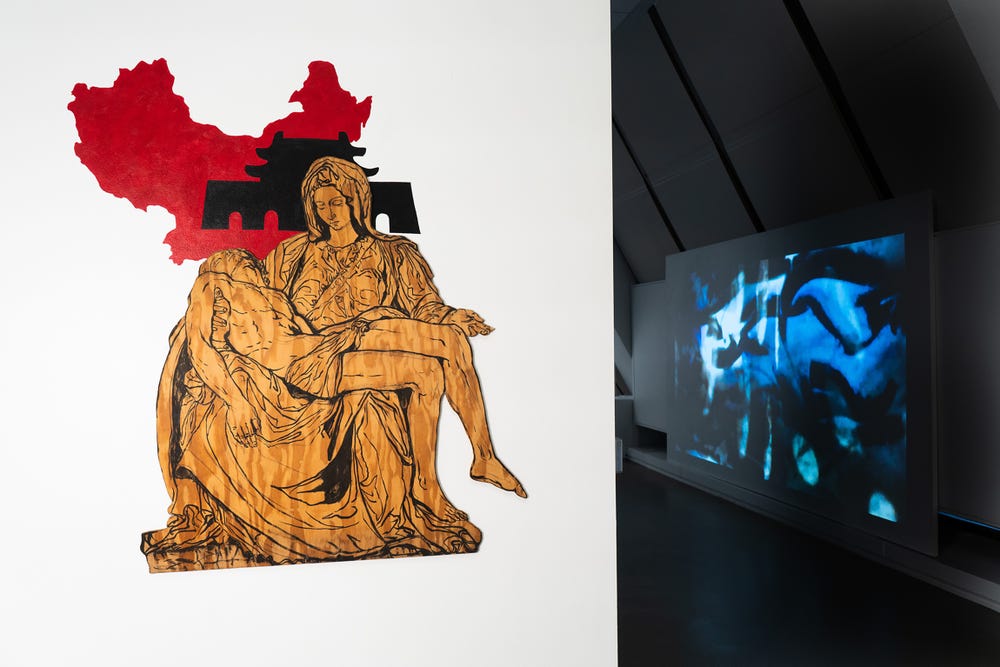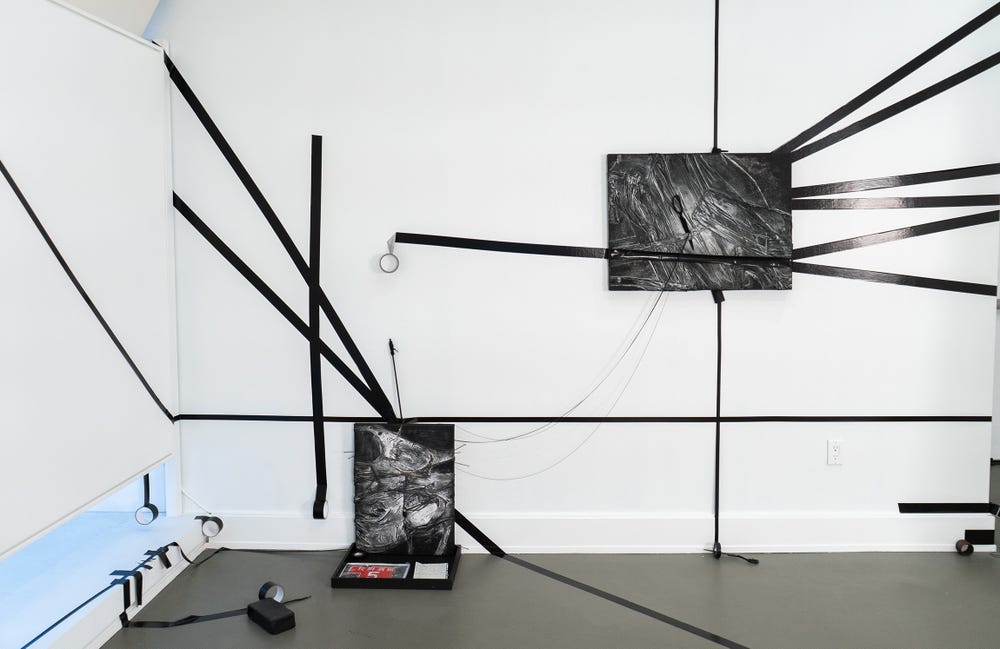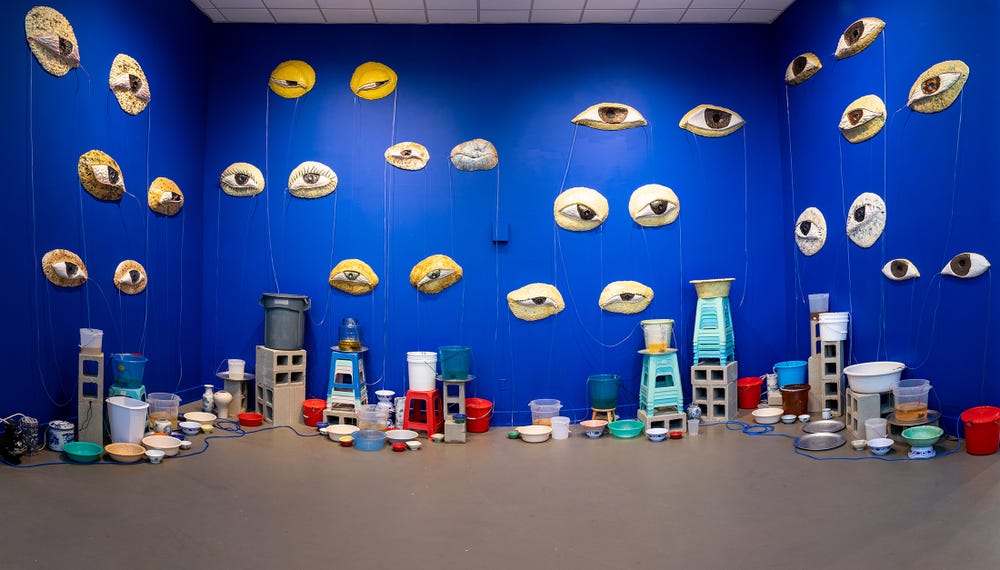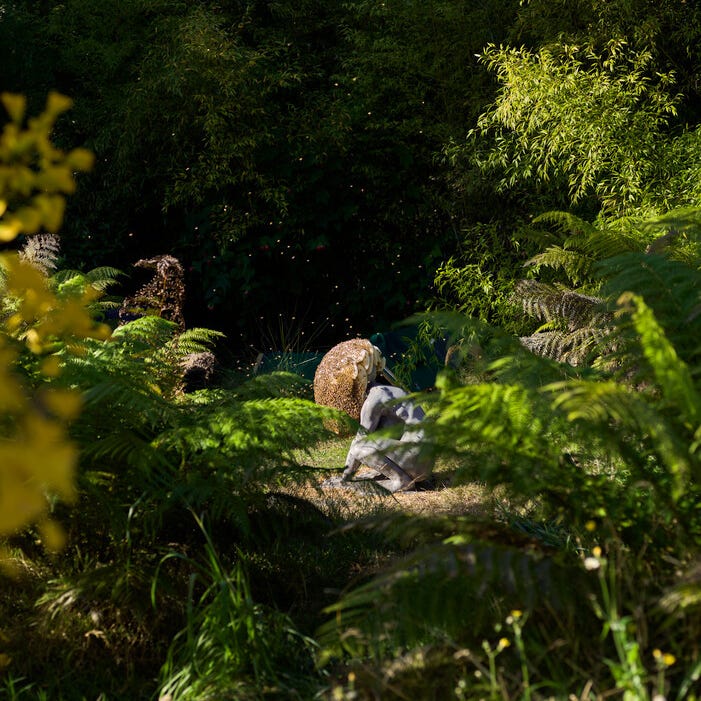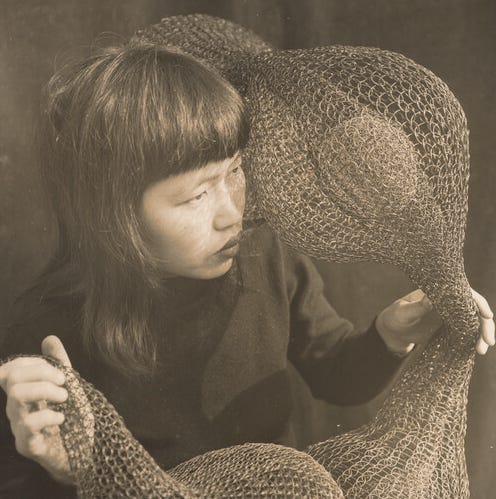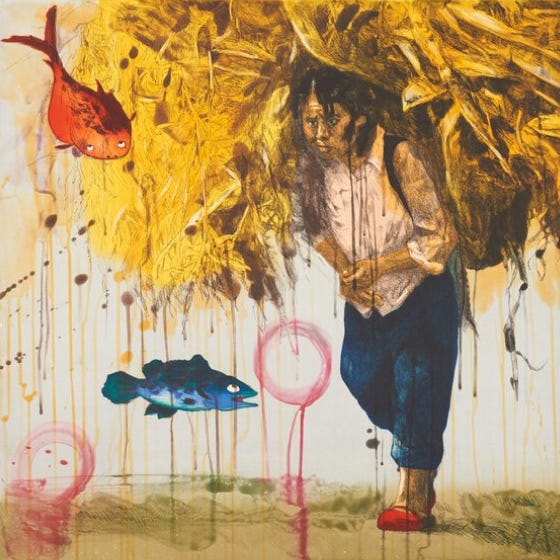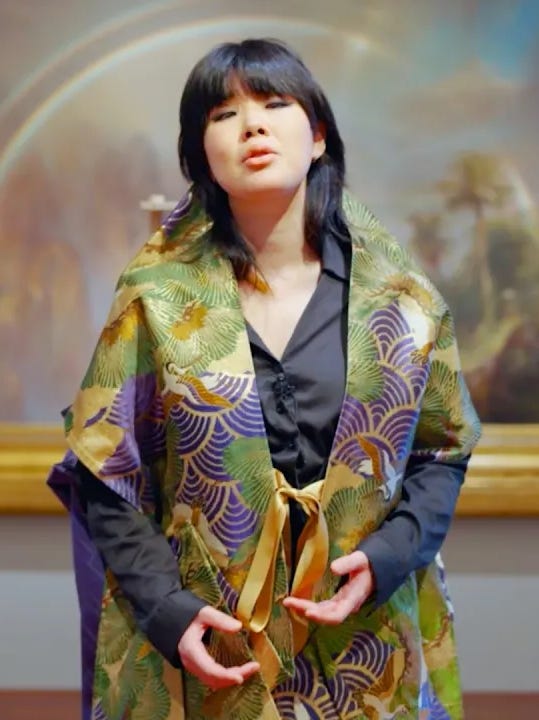Remembering as Liberation: Hung Liu’s Work in Dialogue
By Hoi Leung
May 5, 2022
“Da Jie and I have a similar will for freedom and I really respect her,” artist Stella Zhang said in a recent conversation from her studio in March 2022, reflecting on Hung Liu’s legacy. Throughout our discussion, Zhang referred to Liu as da jie (meaning “older sister” in Mandarin), an endearing nickname given to Liu by a community of immigrant Chinese artist friends. Da jie carries the sense of a protector, a caretaker, and a trailblazer.
Hung Liu: Golden Gate (金門) at the de Young museum provides a moment to reflect on Liu’s relentless attitude toward freedom. By introducing the work of Zhang and Cathy Lu in relation to Liu’s legacy, the exhibition shows how each artist grapples with the failures of history in their artistic gestures toward healing and reconciliation. Putting Liu’s work in dialogue with like-minded Bay Area Chinese American female artists provides insight into the role she played in our local arts community and her lasting imprint on American arts.
Zhang and Liu both graduated from the Central Academy of Fine Arts (CAFA) in Beijing, journeyed to America under unstable circumstances, and, through their art practice, brought their subjectivities into dominant histories as a form of resistance. Zhang and Liu represent two generations of youth at CAFA—one intersecting with the Cultural Revolution and one intersecting with the Tiananmen Square student protest. A sense of unspoken comradery and a shared notion of liberation connect the two artists.
Present Tense: Task of Remembrance, 2019, was a group exhibition at the Chinese Culture Center of San Francisco (CCC) that explored the responsibility of remembering, especially in light of threats to democracy, rising global xenophobia, and ongoing systemic violence and racism. The exhibition was inspired by the 30th anniversary of major local and global upheavals, including the student protests in Tiananmen Square, the Loma Prieta earthquake, and the fall of the Berlin Wall. At CCC, Hung Liu and Stella Zhang exhibited side by side for the first time. Chinese Pietà, 1989, by Liu and Sealed Memory, 2019, by Zhang are pieces that were created in America in response to the Tiananmen Square incident, conceptualized 30 years apart.
Hung Liu, Chinese Pietà, 1989. Installation view at Present Tense: Task of Remembrance. Photograph by Frank Sosa. Courtesy of the Chinese Culture Center
When the Tiananmen Square protests began, Zhang noted that it was an especially youthful, hopeful, and freeing time for young women in China. On June 4 Zhang witnessed the unspeakable — military forces, gunshots, fear, and bodies — followed by systematic silencing and censorship. The traumas that Zhang endured prompted her to leave China, and she had since repressed her memories of 1989. Unbeknownst to Zhang, Liu — who was in Texas then — was one of the many Chinese diasporic artists overseas bearing witness from afar and standing in support of the students. Liu created Chinese Pietà,1989, as part of a larger series of works originally presented at the Woman's Building, Los Angeles. The work is a play on Michelangelo's Pietà, 1498 – 1499, in ink on cut-out plywood, juxtaposed with a painted silhouette of Tiananmen Square and a map of China on the wall. Referencing a deep and unbearable sorrow, Chinese Pietà expresses a mourning for the nation’s future generations.
While Liu’s work was an immediate response to the unjust oppression overseas in China, Zhang’s work represents a moment of reflection and remembrance. “How does one define youth?” she asks in her work Sealed Memory, 2019, the first time she confronts a memory that is both hard to forget and difficult to remember. “Is it unlimited dreams, unforgettable stories, and a stubbornness that cannot be deterred? I remember assembly and protest evolving into violent suppression, tragic endings, and subsequent bans. . . . I cannot help but to contribute to our collective unconscious, our sense of memory.”
Sealed Memory is a floor-to-ceiling installation consisting of black tape, two canvases painted and wrapped with shirts that Zhang made in college, scissor parts, nails, and other raw materials such as brick, dirt, and metal. It’s brash, emotional, spontaneous, and cathartic. The black tape serves as a device to both obscure and render visible; this is reminiscent of Liu’s tactical and evocative drip work that conveys an emotional quality while challenging the fidelity of history. For Zhang and many others, justice was never granted, and yet we must keep remembering to reclaim some sense of agency.
Stella Zhang, Sealed Memory, 2019. Installation view at Present Tense: Task of Remembrance. Photograph by Frank Sosa. Courtesy of the Chinese Culture Center
Today we see that a history of injustice reinvents and repeats itself; in the past year, 74 percent of Asian American and Pacific Islander (AAPI) women reported having personally experienced racism or discrimination, per the National Asian Pacific American Women’s Forum. These statistics, coupled with the harrowing and pervasive images and headlines of violence against Asian women, create a cycle of retraumatization, anger, and grief. It is in this context that artist Cathy Lu created a new body of work during a global pandemic exacerbated by anti-Asian xenophobia.
Lu recalls that her first encounter with Liu was learning about her through art history courses. In the courses Liu was portrayed as a singular Chinese American woman artist. Works like Jiu Jin Shan (Old Gold Mountain), 1994, were particularly vivid for Chinese American artists navigating both their racialized and sexualized identities. Grappling with the excluded status of many of the subjects in Liu’s work — women, the working class, and refugees — as well as her identity as a Chinese American immigrant woman artist, Liu’s inclusion of oppressed voices as central to American art is especially remarkable.
In 2022 — when there had been 10,905 incidents reported to Stop AAPI Hate — Lu debuted a major solo exhibition entitled Interior Garden at CCC, where she transformed the gallery into a contemplative space for reconciliation between the promise of the American dream and the dystopian experiences that so many immigrants and people of color face in the United States. Lu casts a spotlight on voices often dismissed, overlooked, and deemed irrelevant; Asian Americans are viewed as both “perpetual foreigners” and a “model minority.”
Cathy Lu, Peripheral Visions, 2022. Installation view at Interior Garden. Photograph by Aaron Stark. Courtesy of the Chinese Culture Center
One of her new works in the exhibition, Peripheral Visions, 2022, includes 14 pairs of porcelain eyes of East Asian women across generations; the eyes cry perpetually in this sonic and kinetic sculptural work. This piece is reminiscent of the immediacy of Liu’s paintings, masterfully fixing an emotion in time. For Lu, the tears flow endlessly into a loud-yet-hallowing chamber; the collective visions of women confront the oppressors, mourn for our communities, and demand our empathy. Ultimately, Interior Garden provides Asian Americans the space to heal from the many contradictions of our disorienting realities.
Hung Liu’s work reminds us of the need to revisit history, our relationships with it, and our agencies over it. For these three artists, senses of trauma, injustice, and erasure are woven into material manifestations of their journeys toward healing, reconciliation, and, ultimately, liberation.
Text by Hoi Leung, curator at the Chinese Culture Center of San Francisco.
Hung Liu: Golden Gate (金門) is on view July 17, 2021 through August 7, 2022 in Wilsey Court at the de Young museum, a space free to the public.

